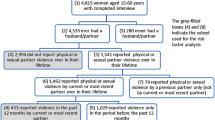Abstract
Objectives
Recent studies suggest that intimate partner violence (IPV) against women in Europe is highest among some of the most gender egalitarian countries in the world, like Sweden, Finland and Denmark. This paper aims at disentangling the so-called Nordic Paradox.
Methods
We have decomposed traditional IPV indicators into a ‘previous partner’ and ‘current partner’ components and presented new IPV indicators that are sensitive to the frequency of victimization. The new indicators are based on aggregated data from Agency for Fundamental Rights Survey on violence against women for the 28 EU Member States.
Results
The country rankings in terms of IPV levels change substantially when overall prevalence measures are substituted by their ‘previous partner’ and ‘current partner’ components and, especially, when considering the frequency of victimization. When comparing the traditional IPV prevalence ranking with the current partner violence repetition-sensitive indicator ranking, the Nordic countries fall several positions.
Conclusions
Our findings suggest that the prevalence of IPV tends to be higher in more gender egalitarian countries because union formation and dissolution occur more often, but not because men are necessarily more violent against their partners.

Source: Authors’ calculations based on the European Union Agency for Fundamental Rights’ survey on Violence Against Women Survey dataset, 2012

Source: Authors’ calculations based on the European Union Agency for Fundamental Rights’ survey on Violence Against Women Survey dataset, 2012
Similar content being viewed by others
References
Bowen E, Gilchrist EA, Beech AR (2005) An examination of the impact of community-based rehabilitation on the offending behaviour of male domestic violence offenders and the characteristics associated with recidivism. Leg Criminol Psychol 10:189–209. https://doi.org/10.1348/135532505X36778
Bybee D, Sullivan CM (2005) Predicting re-victimization of battered women 3 years after exiting a shelter program. Am J Commun Psychol 36(1/2):85–95. https://doi.org/10.1007/s10464-005-6234-5
EIGE—European Institute for Gender Equality (2015) Gender Equality Index 2015. Measuring gender equality in the European Union 2005–2012. Luxembourg, Publications Office of the European Union
EIGE—European Institute for Gender Equality (2017) Gender Equality Index 2017. Measurement framework of violence against women. Luxembourg, Publications Office of the European Union. http://doi.org/10.2839/652585
Ellsberg M, Jansen HA, Heise L, Watts CH, Garcia-Moreno C (2008) Intimate partner violence and women’s physical and mental health in the WHO multi-country study on women’s health and domestic violence: an observational study. Lancet371(9619):1165-1172. https://doi.org/10.1016/S0140-6736(08)60522-X
FRA—European Union Agency for Fundamental Rights (2014) Violence against women: An EU-wide survey. Main results. Luxembourg, Publications Office of the European Union. https://doi.org/10.2811/981927
FRA—European Union Agency for Fundamental Rights (2015) European Union Agency for Fundamental Rights (FRA): Violence Against Women survey, 2012: Special Licence Access. [data collection]. UK Data Service. SN: 7730. http://doi.org/10.5255/UKDA-SN-7730-1
Garcia-Moreno C, Jansen H, Watts C, Ellsberg M (2005) WHO multi country study on women’s health and domestic violence against women. World Health Organisation, Geneva
Garcia-Moreno C, Jansen H, Ellsberg M, Heise L, Watts C (2006) Prevalence of intimate partner violence: findings from the WHO multi-country study on women’s health and domestic violence. Lancet 368(9551):2–8. https://doi.org/10.1016/S0140-6736(06)69523-8
Gracia E, Merlo J (2016) Intimate partner violence against women and the Nordic paradox. Soc Sci Med Elsevier Ltd 157:27–30. https://doi.org/10.1016/j.socscimed.2016.03.040
Gracia E, Martín-Fernández M, Lila M, Merlo J, Ivert AK (2019) Prevalence of intimate partner violence against women in Sweden and Spain: a psychometric study of the “Nordic paradox”. PLoS ONE 14(5):1–17. https://doi.org/10.1371/journal.pone.0217015
Heise L, Kostsadam A (2015) Cross-national and multilevel correlates of partner violence: an analysis of data from population-based surveys. Lancet Glob Health 3:332–340. https://doi.org/10.1016/S2214-109X(15)00013-3
Ivert AK, Gracia E, Lila M, Wemrell M, Merlo J (2019) Does country-level gender equality explain individual risk of intimate partner violence against women? A multilevel analysis of individual heterogeneity and discriminatory accuracy (MAIHDA) in the European Union. Eur J Public Health. https://doi.org/10.1093/eurpub/ckz162
Martín-Fernández M, Gracia E, Lila M (2019) Psychological intimate partner violence against women in the European Union: a cross-national invariance study. BMC Public Health 19:1739. https://doi.org/10.1186/s12889-019-7998-0
Sanz-Barbero B, Corradi C, Otero-García L, Ayala A, Vives-Cases C (2018) The effect of macrosocial policies on violence against women: a multilevel study in 28 European Countries. Int J Public Health 63(8):901–911. https://doi.org/10.1007/s00038-018-1143-1
Stöckl H, Devries K, Rotstein A, Abrahams N, Campbell J, Watts C et al (2013) The global prevalence of intimate partner homicide: a systematic review. Lancet 382(9895):859–865. https://doi.org/10.1016/S0140-6736(13)61030-2
Walby S, Towers J, Francis B (2014) Mainstreaming domestic and gender-based violence into sociology and the criminology of violence. Sociol Rev 62(2014):187–214. https://doi.org/10.1111/1467-954X.12198
Walby S, Towers J, Francis B (2015) is violent crime increasing or decreasing? A new methodology to measure repeat attacks making visible the significance of gender and domestic relations. Br J Criminol. https://doi.org/10.1093/bjc/azv131
Walby S, Towers J, Balderston S, Corradi C, Francis B, Heiskanen M et al (2017) The concept and measurement of violence against women and men. Policy Press, Bristol
Wemrell M, Stjernlöf S, Aenishänslin J, Lila M, Gracia E, Ivert AK (2019) Towards understanding the Nordic paradox: a review of qualitative interview studies on intimate partner violence against women (IPVAW). Swed Sociol Compass 13:e12699. https://doi.org/10.1111/soc4.12699
WHO—World Health Organization (2013) Global and regional estimates of violence against women: prevalence and health effects of intimate partner violence and non-partner sexual violence. World Health Organization, Geneva
Yllö K (1984) The status of women, marital equality and violence against wives. J Fam Issues 5(3):307–320
Funding
The study was supported with funding provided by the European Research Council (ERC-2014-StG-637768, EQUALIZE project), the Spanish Ministry of Science, Innovation and Universities ‘Ramón y Cajal’ Research Grant Program (RYC-2013-14196) and its National R&D&I Plan GLOBFAM (RTI2018-096730-B-I00).
Author information
Authors and Affiliations
Corresponding author
Ethics declarations
Conflict of interest
The authors declare that they have no conflict of interest.
Ethical approval
Not applicable.
Additional information
Publisher's Note
Springer Nature remains neutral with regard to jurisdictional claims in published maps and institutional affiliations.
Electronic supplementary material
Below is the link to the electronic supplementary material.
Rights and permissions
About this article
Cite this article
Permanyer, I., Gomez-Casillas, A. Is the ‘Nordic Paradox’ an illusion? Measuring intimate partner violence against women in Europe. Int J Public Health 65, 1169–1179 (2020). https://doi.org/10.1007/s00038-020-01457-5
Received:
Revised:
Accepted:
Published:
Issue Date:
DOI: https://doi.org/10.1007/s00038-020-01457-5




